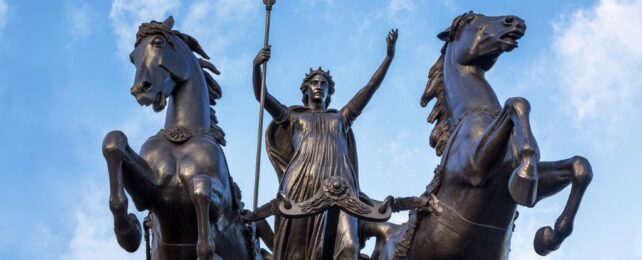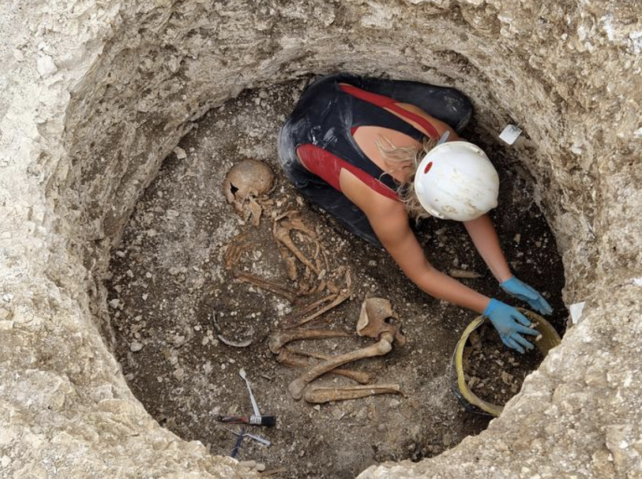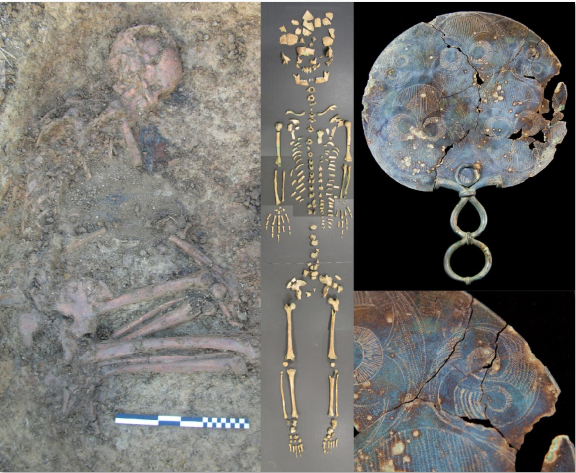 Boudica statue in London. (Rixipix/Getty Images)
Boudica statue in London. (Rixipix/Getty Images)
Around 2,000 years ago, before the Roman Empire conquered Great Britain, women were at the very front and center of Iron Age society.
Researchers have sequenced the genomes of around 50 Celtic Britons buried together in southern England and uncovered strong evidence of female-line descent.
Among the large kin group, who lived before and after the Romans launched their invasion in AD 43, more than two-thirds were descended from a single female ancestor. Meanwhile, 80 percent of the unrelated family members were male.
"This tells us that husbands moved to join their wives' communities upon marriage, with land potentially passed down through the female line," explains geneticist Lara Cassidy from Trinity College Dublin.
"This is the first time this type of system has been documented in European prehistory and it predicts female social and political empowerment."
 Archaeologist uncovering an Iron Age skeleton in Dorset. (Bournemouth University)
Archaeologist uncovering an Iron Age skeleton in Dorset. (Bournemouth University)The Dorset dig was conducted by archaeologists at Bournemouth University, and the genetic study was conducted by researchers at Trinity College London.
To compare what was found at Dorset to the rest of Britain, Cassidy and her fellow geneticists at Trinity sifted through the DNA database of dozens of other Iron Age archaeological sites, scattered across the island.
Celtic Briton cemeteries are rare to find, and usually there are far fewer burials than the one in Dorset. Nevertheless, researchers found several examples of 'matrilocal' societies among the bunch.
They can tell that because mitochondrial DNA is inherited exclusively through the maternal line. In a Yorkshire cemetery from the Iron Age, for example, one dominant matriline dated back to before 400 BCE.
But as Cassidy explained to Becky Ferreira at The New York Times, 'matrilocal' doesn't equate to 'matriarchal'. Men may have also held positions of authority in Celtic Briton society.
Even still, the Romans were no doubt flabbergasted by such a female-dominated structure, where women may have inherited property or been able to divorce.
At archaeological sites, Celtic women often receive the most lavish burials, indicating a high status in society. They also led armies.
Boudica – a warrior queen who is famed for heading a revolt against the Romans – was described by the Roman historian Dio Cassius as "most terrifying" and "possessing greater intelligence than often belongs to women".
Boudica's army sacked two cities, killing 80,000 Romans and their allies. Dio Cassius points out that "all this ruin was brought upon the Romans by a woman, a fact which in itself caused them the greatest shame… "
 Burial of a young woman sampled for DNA, who was buried with a mirror (right panels) and jewelry, including a Roman coin amulet showing a female charioteer representing victory. (Bournemouth University)
Burial of a young woman sampled for DNA, who was buried with a mirror (right panels) and jewelry, including a Roman coin amulet showing a female charioteer representing victory. (Bournemouth University)"It's been suggested that the Romans exaggerated the liberties of British women to paint a picture of an untamed society," explains archaeologist Miles Russell from Bournemouth University, who is leading the excavation at Dorset.
"But archaeology, and now genetics, implies women were influential in many spheres of Iron Age life. Indeed, it is possible that maternal ancestry was the primary shaper of group identities."
In an independent review of the study for Nature, evolutionary anthropologist Guido Alberto Gnecchi-Ruscone argues the evidence is "compelling" and that a 'matrilocal' society, where men move between groups, seems to have been "widespread across the island and practiced over centuries."
The genetic research, Gnecchi-Ruscone continues, validates the claims that women played a special role in Celtic Briton society.
History might be written by the victors, but genes can tell stories, too.
The study was published in Nature.

.jpg) 8 hours ago
1
8 hours ago
1
 English (US)
English (US)